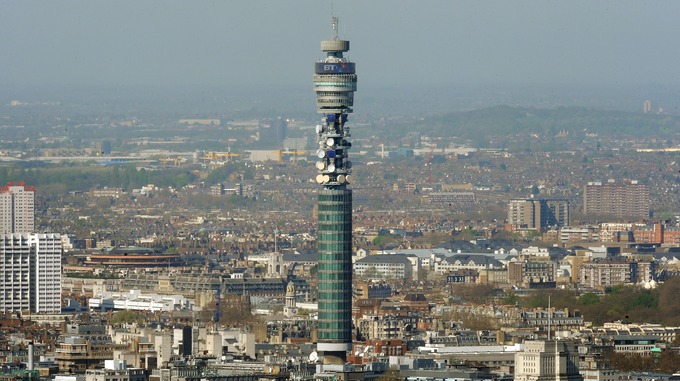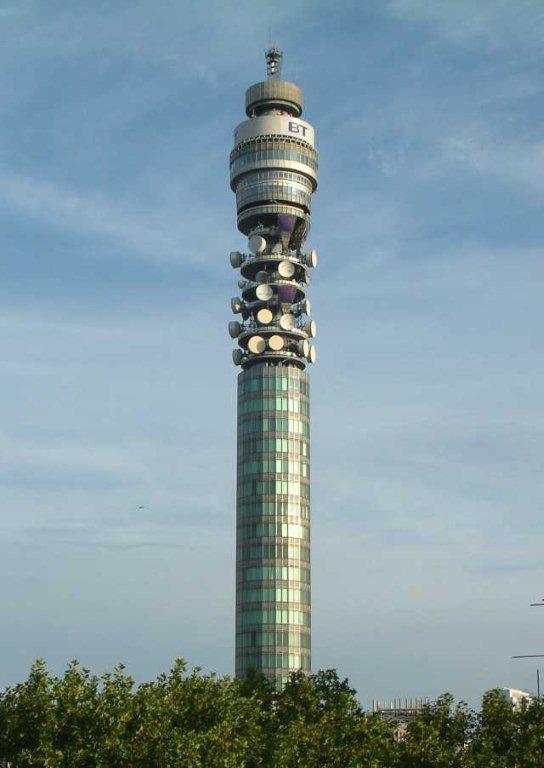BT Tower
Contents |
[edit] Introduction
The BT Tower, formerly known as the Post Office Tower and British Telecom Tower, is a modernist communications tower located in Fitzrovia, London. At 177 m (581 ft), it was the tallest building in the UK when it was completed in 1964, a title it held until the construction of the NatWest Tower in 1980.
It was awarded Grade II listed status in 2003, and with its recognisable cylindrical design, it remains one of the most prominent and iconic landmarks of London.
Built in response to the need for modern telecommunications capabilities, the tower was commissioned by the General Post Office (GPO) and designed by the architects of the Ministry of Public Building and Works led by G.R. Yeats to be the first purpose-built tower to transmit high frequency radio waves. The height was necessary in order that signals could successfully pass over the Chiltern hills on the northern rim of the London basin.
The tower was also well-known for its revolving restaurant on the 34th floor, the only one of its kind in London, although this was closed in 1980.
Today, the tower serves as a functioning telecommunications centre, relaying broadcast, internet and telephone communications around the world. However, it remains closed to the public, with the exception of occasional charity or corporate events.
[edit] Design and construction
The tower was commissioned and to become an integral feature in the UK’s modern microwave telecommunications network at the height of the Cold War. Having considered the buildings that survived the Hiroshima and Nagasaki nuclear attacks, planners envisaged that the cylindrical design would be capable of withstanding a similar exchange. The shape also gave the tower good stability under wind loading important for the positioning of its communications aerials.
The tower, built by principal building contractors Peter Lind & Co., is made from 13,000-tonnes of concrete, steel and glass. The foundations are sunk through 53 m of clay, with a concrete raft 27 sq. m, reinforced with six layers of steel cable beneath a reinforced concrete pyramid.
The floors are split as follows:
- First 16 floors: Utility platforms for radio, ventilation, power units and refrigeration.
- Above 16th floor: A 35 m open section for microwave antennae, aerials and satellite dishes.
- 6 further floors for function and other utility rooms.
- 34th floor: A restaurant built on a 3 m wide revolving segment at the outer perimeter, capable of turning at 0.17 km/h, or a full 360-degree revolution every 22 minutes.
- The top is a 40 ft high London Weather Centre radar mast.
Two high speed lifts travel vertically through the building at 6 m/s and distinguish the tower as being the only building in the country that Parliamentary legislation has ruled can be evacuated by lift in the event of emergency.
Work began in 1961 and was officially opened by the then-Prime Minister Harold Wilson in October 1965. It cost an estimated £2.5 million to build.
[edit] Post-completion
Throughout the 1960s, the ‘Top of the Tower’ restaurant was a major attraction, with 1.5 million visitors in its first year.
A bomb attributed to the Provisional IRA was exploded on the 31st floor in October 1971, which claimed no lives but resulted in two years-worth of repair work. BT took the decision that public access was too much of a risk and the restaurant was finally closed in 1980.
With then-Prime Minister Margaret Thatcher’s privatisation of the GPO in 1984, the tower was renamed the British Telecom Tower. In 1992, the company’s re-branding meant that it became known as the BT Tower.
Despite appearing in numerous TV, literary and film works, the tower was technically considered a ‘secret’ and was not included on any official maps. In 1993, its existence was ‘confirmed’ in Parliament.
In 2009, BT announced that the restaurant would be reopening, although these plans were abandoned shortly after.
[edit] Project data
- Address: 60 Cleveland Street, London W1
- Construction started: 1961
- Completed: 1964
- Height: 177 m
- Floors: 37
- Architect: Eric Bedford
- Main contractor: Peter Lind & Co.
- NatWest Tower.
- Construction cost: £2.5 million
- Owner: BT Group
[edit] Related articles on Designing Buildings Wiki
- 7 Engineering Wonders of the world.
- Building of the week series.
- City Hall, London.
- CN Tower.
- Emley Moor transmitting station.
- Leadenhall building.
- Lloyd’s of London.
- Millennium Dome.
- One Canada Square.
- Skyscraper.
- Space Needle.
- Tallest buildings in the world.
- The Gherkin.
- The history of fabric structures.
- The Shard.
- Thames barrier.
- Trellick Tower.
- Welbeck Street car park.
- Wembley Stadium.
[edit] External references
- Urban75.org - BT Tower
Featured articles and news
The UK's Modern Industrial Strategy: A 10 year plan
Previous consultation criticism, current key elements and general support with some persisting reservations.
Building Safety Regulator reforms
New roles, new staff and a new fast track service pave the way for a single construction regulator.
Architectural Technologist CPDs and Communications
CIAT CPD… and how you can do it!
Cooling centres and cool spaces
Managing extreme heat in cities by directing the public to places for heat stress relief and water sources.
Winter gardens: A brief history and warm variations
Extending the season with glass in different forms and terms.
Restoring Great Yarmouth's Winter Gardens
Transforming one of the least sustainable constructions imaginable.
Construction Skills Mission Board launch sector drive
Newly formed government and industry collaboration set strategy for recruiting an additional 100,000 construction workers a year.
New Architects Code comes into effect in September 2025
ARB Architects Code of Conduct and Practice available with ongoing consultation regarding guidance.
Welsh Skills Body (Medr) launches ambitious plan
The new skills body brings together funding and regulation of tertiary education and research for the devolved nation.
Paul Gandy FCIOB announced as next CIOB President
Former Tilbury Douglas CEO takes helm.
UK Infrastructure: A 10 Year Strategy. In brief with reactions
With the National Infrastructure and Service Transformation Authority (NISTA).
Ebenezer Howard: inventor of the garden city. Book review.
The Grenfell Tower fire, eight years on
A time to pause and reflect as Dubai tower block fire reported just before anniversary.
Airtightness Topic Guide BSRIA TG 27/2025
Explaining the basics of airtightness, what it is, why it's important, when it's required and how it's carried out.
Construction contract awards hit lowest point of 2025
Plummeting for second consecutive month, intensifying concerns for housing and infrastructure goals.
Understanding Mental Health in the Built Environment 2025
Examining the state of mental health in construction, shedding light on levels of stress, anxiety and depression.























